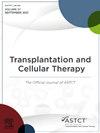Fludarabine Plus Myeloablative Dose of Busulfan Regimen Was Associated with High Nonrelapse Mortality in Allogeneic Hematopoietic Stem Cell Transplantation for Malignant Lymphoma: A Propensity Score-Matched Comparison Study with Fludarabine Plus High-Dose Melphalan
IF 4.4
3区 医学
Q2 HEMATOLOGY
引用次数: 0
Abstract
In recent years, there have been notable advancements in the treatment of malignant lymphoma. However, a certain percentage of patients are unlikely to achieve a cure through chemotherapy alone. Therefore, allogeneic hematopoietic stem cell transplantation (allo-HSCT) remains a crucial curative treatment for malignant lymphoma. FluBu4, comprising fludarabine (Flu) combined with a myeloablative dose of intravenous busulfan (Bu; 12.8 mg/kg in total), is a widely used conditioning regimen for allo-HSCT, but its usefulness in malignant lymphoma (ML) has not been fully investigated. The objective of this study was to evaluate the efficacy and safety of FluBu4 in allo-HSCT for lymphoma by comparing the outcomes of two conditioning regimens: FluBu4 and FluMel140. We used a Japanese national database from the Transplant Registry Unified Management Program to retrospectively analyze the first allo-HSCT for ML in patients aged ≥16 years. Allo-HSCT cases treated with posttransplant cyclophosphamide were excluded. Two groups, namely FluBu4 and FluMel140 were selected by propensity score matching (PSM) with a case ratio of 1:2. From 921 cases, 113 were selected by PSM for the FluBu4 group and 226 for the FluMel140 group. The median age was 54 (19 to 68) years, the median observation period of survivors was 33.8 months, and 145 (42.7%) had a history of autologous HSCT. There were no significant differences in patients’ backgrounds between the two groups after PSM. Three-year overall survival (OS) was significantly worse for FluBu4 than for FluMel140 (28.0% versus 48.6%; P < .01). The 3-year cumulative relapse rate was comparable for FluBu4 and FluMel140 (40.1% versus 38.5%; P = .65). However, 3-year nonrelapse mortality was significantly higher for FluBu4 than for FluMel140 (35.3% versus 22.5%; P = .02). There was no significant difference between the two treatment groups in the cumulative incidence of acute graft-versus-host disease (aGVHD) at day 100 after allo-HSCT and the 3-year cumulative incidence of chronic GVHD. While the common and major cause of death was the relapse of lymphoma, aGVHD, and noninfectious lung complications were observed more frequently with FluBu4 than with FluMel140. One-year cumulative incidence of interstitial pneumonia was significantly higher for FluBu4 than for FluMel140 (5.3% versus 0.4%; P = .03). FluBu4 use was associated with worse nonrelapse mortality (NRM) and OS in allo-HSCT for ML compared with FluBu4 and FluMel140 adjusted by PSM. Patients treated with FluBu4 had a higher incidence of noninfectious pulmonary complications and an increased number of associated deaths. A higher rate of NRM in the patients treated with FluBu4 was particularly evident in patients aged ≥60, and its use should be avoided in this patient population.
氟达拉滨加骨髓清除剂量的布苏凡方案与恶性淋巴瘤异基因造血干细胞移植的高非复发死亡率相关:一项倾向评分匹配的比较研究与氟达拉滨加大剂量美伐兰。
背景:近年来,恶性淋巴瘤的治疗取得了显著进展。然而,一定比例的患者不太可能通过单独的化疗获得治愈。因此,同种异体造血干细胞移植(allo-HSCT)仍然是恶性淋巴瘤的重要治疗方法。目的:FluBu4,由氟达拉滨(Flu)联合清髓剂量静脉注射丁硫凡(Bu;12.8 mg/kg),是一种广泛用于同种异体造血干细胞移植的调理方案,但其在恶性淋巴瘤(ML)中的有效性尚未得到充分研究。本研究的目的是通过比较FluBu4和FluMel140两种治疗方案的结果,评估FluBu4在治疗淋巴瘤的同种异体造血干细胞移植中的疗效和安全性。研究设计:我们使用来自移植登记统一管理计划的日本国家数据库,回顾性分析年龄≥16岁的ML患者的首次同种异体造血干细胞移植。排除同种异体造血干细胞移植后使用环磷酰胺治疗的病例。采用倾向评分匹配法(PSM)选择FluBu4和fluumel140两组,病例比为1:2。结果:921例患者中,经PSM筛选FluBu4组113例,fluumel140组226例。中位年龄为54岁(19-68岁),幸存者中位观察期为33.8个月,145例(42.7%)有自体造血干细胞移植史。PSM后两组患者背景无显著差异。FluBu4的3年总生存率(OS)明显低于flume140 (28.0% vs 48.6%;P < 0.01)。FluBu4和fluumel140的3年累积复发率相当(40.1% vs 38.5%; = 0.65页)。然而,FluBu4的3年非复发死亡率显著高于fluumel140 (35.3% vs 22.5%; = 0.02页)。同种异体造血干细胞移植后第100天急性移植物抗宿主病(aGVHD)的累积发病率和慢性移植物抗宿主病(GVHD)的3年累积发病率在两个治疗组之间无显著差异。虽然常见和主要的死亡原因是淋巴瘤复发,但FluBu4组比flume140组更频繁地观察到aGVHD和非感染性肺部并发症。FluBu4组间质性肺炎的一年累积发病率显著高于flume140组(5.3% vs. 0.4%; = 0.03页)。结论:与经PSM调节的FluBu4和fluumel140相比,FluBu4的使用与ML的alloo - hsct的NRM和OS更差相关。接受FluBu4治疗的患者非感染性肺部并发症发生率较高,相关死亡人数增加。在年龄≥60岁的患者中,使用FluBu4治疗的患者NRM发生率较高,应避免在该患者群体中使用。
本文章由计算机程序翻译,如有差异,请以英文原文为准。
求助全文
约1分钟内获得全文
求助全文
来源期刊

Transplantation and Cellular Therapy
Medicine-Hematology
CiteScore
7.00
自引率
15.60%
发文量
1061
审稿时长
51 days
 求助内容:
求助内容: 应助结果提醒方式:
应助结果提醒方式:


